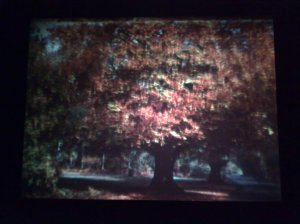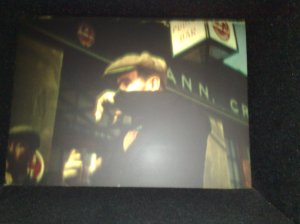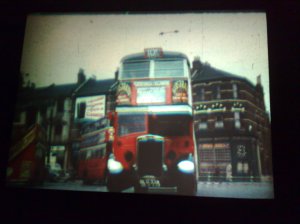As you know, Lloyd and I have been deep in the bowels of the BFI, watching films. Seeing so many at once is a little overwhelming, so I thought I’d leave a few days for them to sink in. Now, a sense of each of them is beginning to emerge. And to be honest, I’m more than a little surprised by the films that have really captured my imagination.
Two films have really stood out: Mary Field‘s The Life Cycle of the Onion
, and The Green Girdle
, shot by Jack Cardiff for Ralph Keene. Field’s film is – for the most part – a stop motion record of onions growing, from seed to reseeding. The Green Girdle
records the parks around London, in full technicolor. Both films focus, tightly and plotlessly, on a small part of life; and each is absolutely stunning, in terms of both initial impact and insight generated.
To start with Life Cycle of the Onion
. We live in an age when the nature documentary has become an epic form. To be excited, we must be shown footage of truly wild subjects in truly wild environments; and we must know that a film crew has battled across huge distances, or through overwhelming environments, or even just waited in hides for weeks or months, to get that footage.
Life Cycle of the Onion
is the exact opposite of this. It shows an onion, growing; and that’s it. A seed buds; that bud becomes a stalk; the stalk thickens; and a new plant appears. Stop motion filming is the only technical trick used, condensing the onion’s life cycle into ten minutes or so. With a little time and effort, any one of us could step into our back gardens and witness this.
And yet this is an astonishingly compelling film. The rapid movement of the growing onion is hypnotic; there’s something profoundly intimate in the way that the film takes such slow, private growth and exposes it to public view. Watching new life bloom, we become aware that we are watching something truly secret – something that, before film could control time, was hidden from us all.
It’s that control of time, and the consequent revelation of the hidden, that also makes Mary Field’s film a profoundly surreal experience. When our experience of time changes, our experience of all that is caught within it changes too. By pulling her onion out of real time, and into film time, Mary Field makes it something rich and strange; a vivid new creature, all pulsing tentacles and living movement, bursting out of the earth and reaching for the sun.
That shifted experience is a profound reminder of the unreal nature of film. No film is a reproduction of reality; each one is an approximation of it, a manipulation of it, a remaking of it. That sense of remaking is profoundly present The Green Girdle
, a small masterpiece leant very literal brilliance not by its director, but by its cameraman, Jack Cardiff.
I’ve got to stop for a moment here, and declare a personal interest. Jack Cardiff was Powell and Pressburger‘s director of photography on their 40s classics A Matter of LIfe and Death
, Black Narcissus
and The Red Shoes
. These complex, brilliant films are among the greatest ever made; peaks of British imaginative cinema that drew on some of Europe’s finest creative talent to respond – with dazzling style – to the new complexities of the post war world, and to refute the then-dawning tradition of British realist film making.
If you’ve seen them, you’ll know why I’m enthusing about them; if you haven’t, then nothing I can write will do them any sort of justice. Go and see them! I hope you get as much out of them as I’ve done, over the years. One of the things that I’ve always loved about them is their deep awareness of the fictive nature of film – and Jack Cardiff’s camerawork is at the heart of that awareness.
Cardiff was one of the early masters of Technicolor. His camera creates a world that reflects the vivid colours of reality, but that does so in a way that is clearly, beautifully artificial. Watching these films, we are always aware that we’re not watching reality; we’re watching a technology reproducing reality. That Cardiff-driven awareness is a core component of Powell and Pressburger’s broader artistic project; but it is only a component.
In The Green Girdle
, by contrast, the medium of Technicolor is the real subject of the film. There is no plot; there are no characters; there are only a series of landscapes, burning off the screen. Shot in autumn, the film explodes with colour. Cardiff’s amazed joy at the visual capabilities of the new technology is brilliantly evident in every frame. It’s like peeking into the sketchbooks of an early Renaissance master painter, as he discovers perspective. I took some pictures off the screen; they don’t really catch the brightness of the film, but they give at least some idea of it.

An Autumn Tree

A man drinks in Technicolor
And again, we’re reminded of the unreal nature of film. Like Life Cycle of the Onion
, The Green Girdle
is honestly, joyfully abstract. At one point, some bison pop up, grazing contentedly. Within the film’s invented world, their Sussex presence seems entirely reasonable. ‘OF COURSE that’s what cows look like in Technicolor’, I said. ‘It makes perfect sense’, agreed Lloyd.

The Bison of Sussex
And these films – so unambitious, so honest, so startling – make perfect sense too. They remind us that every film creates a partial version of the world. Each one is – in the deepest sense – an edited artefact. And it’s that editing, that partiality that brings hidden aspects of the world into sharp, surprising, revelatory focus, that is at the heart of documentary, and of all the films we’ve been watching.

A Red Bus
Filed under: film archive | Tagged: documentary, Jack Cardiff, Life History of the Onion, Mary Field, Ralph Keene, Technicolor, The Green Girdle | Leave a comment »






![Reblog this post [with Zemanta]](https://i0.wp.com/img.zemanta.com/reblog_e.png)


